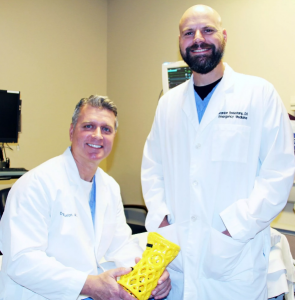Description
The industry leader for custom-made 3D-printed casts and splints in the United States, ActivArmor™ empowers patients with the freedom to be able to maintain their active lifestyles. Now, they begin producing custom-fit, low-cost reusable face masks that achieve a 98.9% to 99.9% bacterial filtration efficiency (BFE) test score. On today’s show, Bob Roark chats with Diana Hall, the President and Founder of ActivArmor™, orthopedic surgeon Dr. Kevin Kaplan, and critical care flight nurse and paramedic Eric Miller about the face masks. Dr. Kaplan and Eric share their experiences wearing the face mask, while Diana explains how they’ve added the product line using their existing technology. They also dive into the company’s cast and its benefits for athletes and regular patients.
---
Watch the episode here:
[embed]https://youtu.be/D1uoZyaf3ls[/embed]
ActivArmor™ With Diana Hall, Dr. Kevin Kaplan And Eric Miller
We have three guests on the show. We have Diana Hall. She's the President and COO of ActivArmor. We have Dr. Kevin Kaplan. He is an orthopedic surgeon with the Jacksonville Orthopedic Institute and Head Team Physician for the Jacksonville Jaguars. We have Eric Miller. He's a critical care flight nurse and paramedic and a Major in the Wyoming Air National Guard. We're going to be talking about ActivArmor, both their casts and their face masks. Eric, tell me a little bit about the face masks and why they're useful and attractive for you to use in your business.
I work on the helicopter, and also work in an ICU. One of the big complaints, if you talk to any healthcare worker about masks, and if you have to wear these things, every time you breathe or exhale, your glasses are fogging up. The ActivArmor mask, I got a 3D scan of my face. This thing fits directly on my face and I don't get that fog in my glasses. I can tell you, if you're in a helicopter, you can't have that happening. It's a safety issue. Being in an ICU, after twelve-hour shifts, it's irritating. The other great thing is the ability to be able to see facial expressions and stuff, especially with patients. It's already scary enough. In this, you can see if you're smiling. If they have trouble hearing, they can see your lips. They're a fantastic tool and the fact that they're N95s, which is great for the situation with the COVID. I use mine all the time.
Eric, you said that you were out flying and that you got your sound boom to work with the mask on.
That's another big issue for me. I can put my visor down. It works like it goes over my nose and then putting the microphone to the side, I was able to still communicate within the cabin with the other crew members and discuss the patient. It was fantastic.
 You were talking about an interest in the hearing-impaired school and potential uses of those masks for the instructors at the school. Could you talk a little bit about your thoughts there?
You were talking about an interest in the hearing-impaired school and potential uses of those masks for the instructors at the school. Could you talk a little bit about your thoughts there?
I was approached by somebody when I was wearing the mask and he says,...